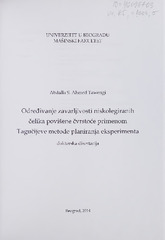Приказ основних података о дисертацији
Evaluation of high strength low-alloyed steel weldability by using Taguchi method for design of experiment
Određivanje zavarljivosti niskolegiranih čelika povišene čvrstoće primenom Tagučijeve metode planiranja eskperimenta
| dc.contributor.advisor | Sedmak, Aleksandar | |
| dc.contributor.other | Prokić-Cvetković, Radica | |
| dc.contributor.other | Majstorović, Vidosav | |
| dc.contributor.other | Milović, Ljubica | |
| dc.contributor.other | Kirin, Snežana | |
| dc.creator | Tawengi, Abdala S. Ahmed | |
| dc.date.accessioned | 2016-11-20T10:38:58Z | |
| dc.date.available | 2016-11-20T10:38:58Z | |
| dc.date.available | 2020-07-03T08:43:07Z | |
| dc.date.issued | 2014-03-06 | |
| dc.identifier.uri | http://eteze.bg.ac.rs/application/showtheses?thesesId=4013 | |
| dc.identifier.uri | https://nardus.mpn.gov.rs/handle/123456789/6996 | |
| dc.identifier.uri | https://fedorabg.bg.ac.rs/fedora/get/o:13529/bdef:Content/download | |
| dc.identifier.uri | http://vbs.rs/scripts/cobiss?command=DISPLAY&base=70036&RID=514525603 | |
| dc.description.abstract | Group of high strength low alloy steel, signs NIONIKRAL60 and NIONIKRAL70, created as the need to replace the steel HY-80 and HY-100, is a serious breakthrough to designers and manufacturers of metal structures, especially pressure vessels, enabling to design and produce Hght steel structure. The main problem in the application of high strength low alloy steels, especially NIONIKRAL 70, their weldability, especially in the case of thicker base material, which is dictated by the requirements of the appropriate structures. The reliability of welds cannot be ensured without proper understanding of weldability therefore the hterature reporting the research on cold cracking phenomenon and weldabhity of HSLA steel is reviewed and studied in the first part of this thesis in order to lay the theoretical foundations of this study. However in view of the importance of high strength low ahoy (HSLA) NIONIKRAL-70 steel, particularly for critical applications such as offshore plat- forms, pipeline and pressure vessels, the second part of this current work reports on an investigation of how to weld this type of steel economically without cold cracking. Using manual metal arc (MMA) welding process and thicker plates of NIONIKRAL-70 steel (up to 30 mm), many experiments through various technological tests such as Controlled Thermal Severity (CTS) test, Y-Groove test and Cabelka-Million test have been carried out both to observe this phenomenon, and to investigate the influencing factors, such as preheating technique, heat input, and electrode type. In addition to detecting cracks themselves, as an indirect indicator of weldabihty, and as a result of experimental research, the distribution of hardness in the welded joints, as well as toughness and fracture toughness of typical cross-sechons of the welded joints have been tested. However, it has been found that there is a risk of cold cracking in NIONIKRAL-70 steel welds... | en |
| dc.format | application/pdf | |
| dc.language | en | |
| dc.publisher | Универзитет у Београду, Машински факултет | sr |
| dc.rights | openAccess | en |
| dc.source | Универзитет у Београду | sr |
| dc.subject | HSLA (NIONIKRAL-70) steel | sr |
| dc.subject | cold cracks | sr |
| dc.subject | weldability teshng | sr |
| dc.subject | preheating | sr |
| dc.subject | hardness | sr |
| dc.subject | toughness | sr |
| dc.subject | Taguchi approach | sr |
| dc.subject | ANOVA | sr |
| dc.title | Evaluation of high strength low-alloyed steel weldability by using Taguchi method for design of experiment | en |
| dc.title.alternative | Određivanje zavarljivosti niskolegiranih čelika povišene čvrstoće primenom Tagučijeve metode planiranja eskperimenta | sr |
| dc.type | doctoralThesis | en |
| dc.rights.license | ARR | |
| dcterms.abstract | Седмак, Aлександар; Кирин, Снежана; Прокић-Цветковић, Радица; Мајсторовић, Видосав; Миловић, Љубица; Таwенги, Aбдала С. Aхмед; | |
| dc.identifier.fulltext | https://nardus.mpn.gov.rs/bitstream/id/7572/Disertacija.pdf | |
| dc.identifier.fulltext | http://nardus.mpn.gov.rs/bitstream/id/7572/Disertacija.pdf | |
| dc.identifier.rcub | https://hdl.handle.net/21.15107/rcub_nardus_6996 |


